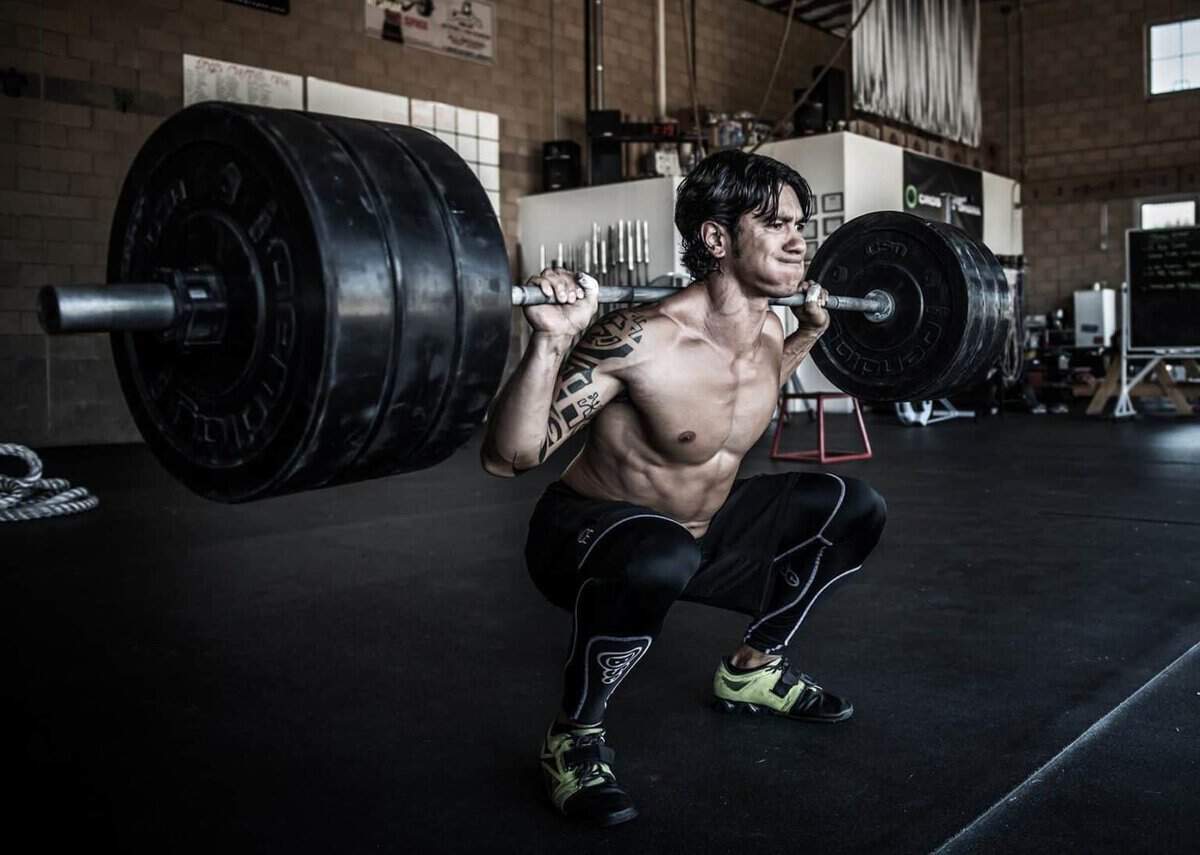In Mundo Entrenamiento we are aware of the importance of strength training methods, both in sports and in the daily practice of physical activity.
That is why we have decided to show you the strength training methods based on previous experience and the objective of the training.
In the following tables, different strength training methods are presented, mainly considering the goal you want to achieve.
Technical learning and anatomical adaptation as a method of strength training
The objective of these strength training methods is, on one hand:
- Teach the techniques of the different exercises (bench press, clean, squat) to later be able to increase the training loads (1).
- Adapt the body to the execution of these exercises with a load slightly higher than that of technical learning (1).
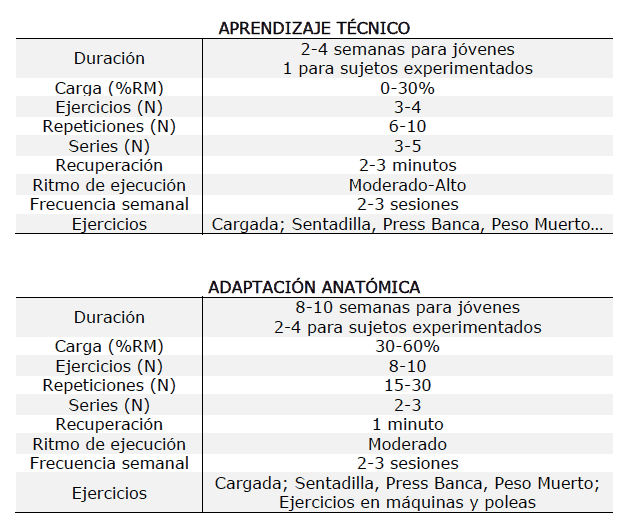
Maximum strength training methods
As we have seen previously in Mundo Entrenamiento, maximum strength improves through the neural and structural mechanism (hypertrophy).
Depending on the importance we want to give to each mechanism, we find different strength training methods for improving that maximum strength (2).
Concentric strength training methods
It is one of the most used strength training methods. The loads are very high, and the exercise focuses its activity on the concentric phase of the movement, hence the concentric phase is performed at a higher speed than the eccentric (execution rhythm) (2).

View this post on Instagram
Eccentric training methods
It is a way to increase the load we can move, exceeding 100% of the 1RM. As we see, it is a method where only the eccentric phase of the movement is worked on.
It is a very complex method where only very experienced subjects should practice it since the muscle damage and the risk of injury are very high (3).

Hypertrophic training methods
Perhaps the most used training methods in the fitness world, but not the most relevant when it comes to improving strength in professional athletes (except in bodybuilding).
Everything related to this method is explained in this article, previously published in Mundo Entrenamiento.
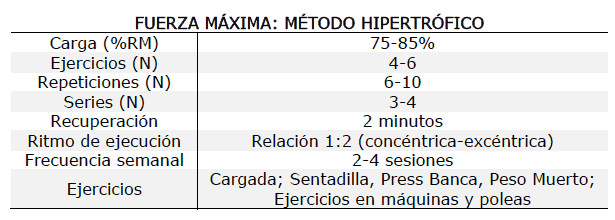
Strength-endurance training methods
This strength training method is similar to the previous one. It simply decreases the load (intensity) of the training and increases the number of sets and repetitions (volume).
These strength training methods are very suitable to perform before carrying out the hypertrophic training method or the concentric method.

View this post on Instagram
Explosive and reactive strength training methods
These strength training methods are based on exercises where the speed of movement is the most important aspect and where the stretch-shortening cycle (SSC) is present, where the concentric and eccentric phases act in a short period of time (2).
Depending on the training objectives, the complexity and type of exercises can be expanded.
In the reactive-explosive method, exercises are performed with body weight or light loads, and the complexity increases as the jump heights become higher (lower table).
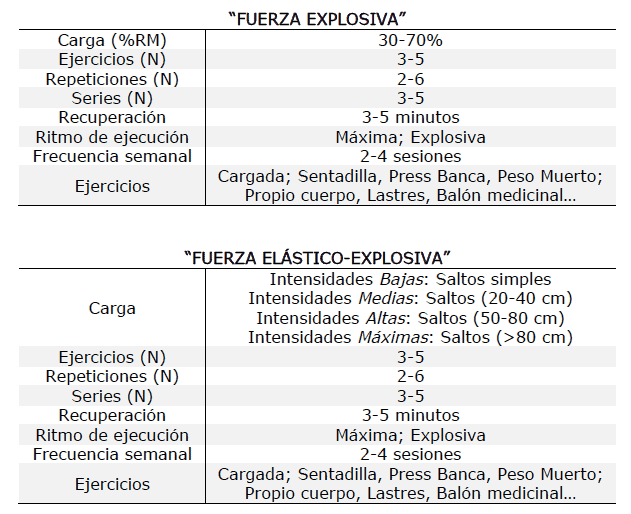
Strength training zones
Strength occupies an essential place for any human being, whether as a fundamental physical capacity, performance limiter, or to ensure the execution of any motor action.
The training of strength, using resistances that act through gravity (free weights, lever machines, etc.) or other forms (hydraulic machines, bands, springs, etc.).
It is also considered an essential activity to ensure adequate physical performance applied to any sport, mobility, and functioning of the locomotor system, as well as to improve functional independence in older adults (4, 5, 6, 7, 8).
Relationship between strength, speed, and power
The study of the relationship between strength, speed, and power in resistance exercises has allowed differentiating zones and strength training methods where each of these variables manifests differently (9).
These are the known “strength training zones.” González-Badillo and Gorostiaga (10) identify three zones (figure 1) that can be distinguished by the predominance of one capacity over the other two:
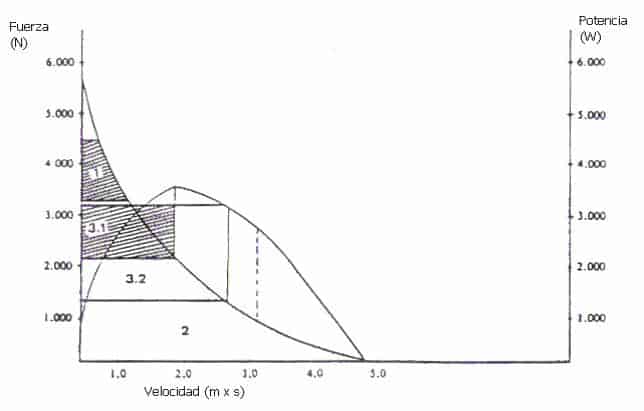
- In zone 1, when very high resistances are used, between 85% and 100% of 1 RM, the applied force is greater, the speed reached is very low, and the power produced is submaximal, as the speed is minimal (11, 12).
- In zone 2, when using very low resistances, between 30% and 45%, the applied force is lower, the speed reached is higher, and the power produced is submaximal, as the force is minimal, and therefore the power value produced will not be very high.
- In zone 3, when using intermediate resistances, between 45% and 80% – 85% of 1 RM, the applied force and speed are not maximal, but they reach intermediate values, producing the highest levels of mechanical power (13, 14).
Within this zone, two areas can be distinguished:
- Area 3.1, where the level of resistances used is higher, between 55-60% up to 80-85% of the 1 RM level, the applied force is higher, and the speed reached is lower.
- Area 3.2, where the weights used are lighter, between 45% up to 55%-60% of 1 RM, the applied force is lower, and the speed reached is higher.
Interactive test on strength training
Before continuing with the reading, we encourage you to take this test to test your knowledge about strength training. Do you dare? We anticipate that if you take it, you will have a final prize.
Different manifestations of strength
Below are the different manifestations, regarding the maximum percentage, estimated by the value of 1 RM, the level of speed or power reached with each percentage of weight used, and the evolution of mechanical power from the lowest to the maximum weights, considering the execution mechanics of three basic exercises:
- Free bar squat (full article here).
- Free bar bench press (figure 2) (full article here).
- Clean and jerk.

The analysis of figure 3 provides us with the possibility of choosing the weights, and the speeds or powers with which they should be moved, to train each of the mentioned manifestations, as each is contained within a zone delimited by a percentage range of weights, a level of movement speed, and especially mechanical power (11, 15, 16, 12).
For maximum strength training, weights between 85% and 100% of 1RM will be used (11, 15). For speed strength, lighter weights will be used, between 25% to 55% in explosive strength and more than 55% up to 80% for power strength (11, 15, 16, 12).
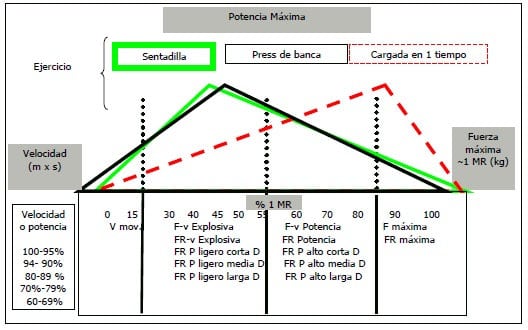
For strength endurance, several training zones can be determined, based on the percentages of speed and power produced, allowing differentiation of areas with low speed or power to zones with high speeds or powers, depending on whether it occurs between 50% and 90% or 93% of the maximum speed or power possible to produce with the weights used (11, 12).
Conclusions on strength training methods
The design of training programs requires considering the specific objectives pursued in each case, which can be successfully addressed if the adaptations caused by systematically addressing the training of each of the forms of strength manifestation described in figure 2 are known with certainty.
We must know with precision the existing strength training methods to adequately plan all our training.
The strength training methods are essential to improve our performance and prevent injuries.
Bibliography
- Notes from the subject “Theory and Practice of Sports Training”. Degree in Physical Activity and Sports Sciences. University of A Coruña. Academic year 2010-2011. Unpublished material.
- Notes from the module “Methodology of Strength Training”. Master’s in High-Performance Sports. Autonomous University of Madrid & Spanish Olympic Committee. Olympic Center for Higher Studies (COES). Academic year 2013-2014. Unpublished material.
- Rodríguez-Casares, R; Aguado, X; Alegre, L. (2012). Low intensity eccentric exercise and muscle damage in young women. A pilot study. CCD. 19(7): 25-34.
- Colado, J.C. (2004). Considerations prior to starting a physical training program. In Colado Sánchez, J.C. (Ed.), Physical conditioning in the aquatic environment (1st ed., pp. 64-98). Barcelona: Paidotribo.
- Fleck, S.J. and Kraemer, W.J. (1997). Designing Resistance Training Programs (2nd ed.). Champaign IL: Human Kinetics.
- Jiménez, A. (2003). Strength and health, Musculoskeletal Fitness, strength training and health. Barcelona: Ergo.
- Macaluso, A. and De Vito, G. (2004). Muscle Strength, power and Adaptation to resistance training in older people. Eur J Appl Physiol. 91, 450-472.
- Newton, R.U.; Häkikinen, K.; Häkikinen, A.; Mccormick, M.; Volek, J. and Kraemer, W. (2002). Mixed Methods of resistance training increases power and strength of young and older men. Med Sci. Sports Exerc. 34(8), 1367-1375.
- González, J.J. and Gorostiaga, A.D.E. (2000). Methodology of Training for Strength Development. Master’s in High-Performance Sports. Madrid: Olympic Center for Higher Studies.
- Bosco, C. (1991). New Methodologies for the evaluation and programming of training. Revista di Cultura Sportiva. (SDS) (22), 13-22.
- Naclerio, A.F. (2005). Strength training and exercise prescription. Personal training, bases, fundamentals, and applications (1st ed., pp. 87-133). Barcelona: Inde.
- Bosco, C. (2000). Muscle Strength Methodological Aspects. Barcelona: Inde.
- Cronin, J. and Sleivert, G. (2005). Challenges in understanding the influence of maximal power training on improving athletic performance. Sports Med. 35(3), 213-234.
- Naclerio, A.F. (2001). Weight strength training: how to determine the intensity of effort and the different types of strength to train. Revista Digital Buenos Aires – Year 6 – No. 29.
- Naclerio, A.F. (2004). Volume in resistance strength training. Revista Digital – Buenos Aires – Year 10 – No. 74.
- Naclerio, A.F; Jiménez, D. (2007): Resistance strength training: how to determine training zones.Journal of Human Sport & Exercise. 2, (2):42-52.
